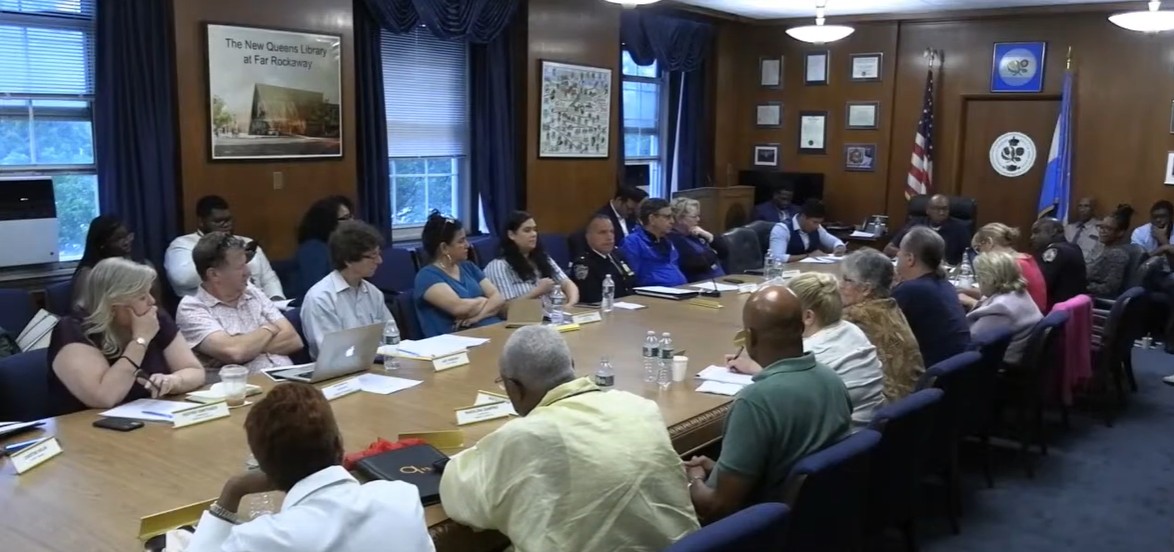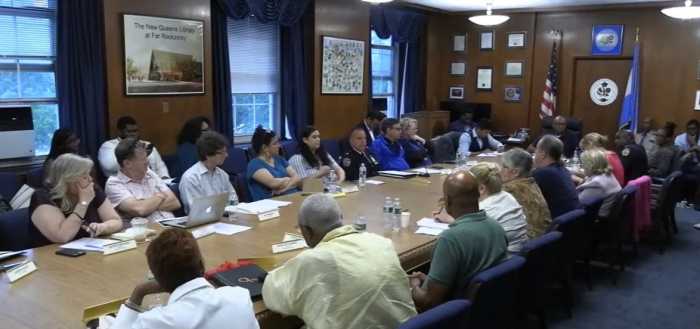By Ronda Kaysen
As Downtown residents brace for years of drilling and street closures outside their apartment windows while the mammoth rebuilding process gets underway, construction czar Charlie Maikish is searching for ways to ease the burden.
Last February, the governor and the mayor appointed Charles J. Maikish, a longtime Downtown figure who spent most of his career building and managing the World Trade Center, to launch and steer a new Lower Manhattan Construction Command Center. Under the auspices of the Lower Manhattan Development Corporation (the center is temporarily housed across the hall from the L.M.D.C. at 1 Liberty Plaza), the command center’s main purpose is to ease the construction burdens facing Downtown residents.
Some of the construction has already begun. Work on a new Fulton St. transit hub began in February and 7 W.T.C. will open in 2006. But there is much more to come, including the Freedom Tower, the memorial and cultural center, a 40-story Goldman Sachs headquarters in Battery Park City, a new West St. promenade and a Santiago Calatrava-designed PATH station and transit hub. Downtown will enter a phase of heavy construction by March 2006, with a peak that will last through 2009. The office will remain open at least until the end of 2010.
Residents — long resigned to living in a neighborhood besieged first by the attacks on the World Trade Center and then by an exhausting cleanup process that eventually morphed into years of wrangling about future developments — wonder how much relief any new governmental office could actually bring.
“All those things sound really great, but when they’re put into practice, I don’t know how well they really work,” Charis San Antonio Cooper, a 150 Nassau St. resident, said of the command center and other public service-type city programs.
Developer Bruce Ratner has plans to build a 75-story, Frank Gehry-designed residential tower in a parking lot on Beekman St. that abuts her building — and her one-year-old son’s bedroom window. “Everybody says the worst part is the pile driving and that can take a few months. Should I be out of my house for a few months?”
Maikish makes no bones about it: the construction process will be loud, disruptive and aggravating at times. His office cannot prevent pile driving when pile driving is required, such as at Site 5B, a 1.1 million sq. ft. residential development soon to break ground in Tribeca across the street from P.S. 234, a neighborhood elementary school. What his office can do, Maikish says, is minimize the chaos and provide information so residents know when to don the earplugs and how long they’ll be traversing dismantled sidewalks as they trek to and from the grocery store.
“For most people, if they’re informed as to what’s going to happen and when and for how long and their informed about what’s being done to mitigate the impact, they’re generally accommodating,” said Maikish in an interview with Downtown Express at his Liberty St. office. “It’s surprises they don’t like. It’s trying to get down the street and finding there’s a crane parked on the street. It’s those kinds of things that really tend to annoy people and get them incensed.”
In October, Maikish hopes to take over Lowermanhattan.info, an L.M.D.C.-funded city Web site, and revamp it to include real time information with an alert system. He hopes to incorporate graphics of what Downtown will eventually look like, once the jackhammers and concrete trucks have left. “That kind of visualization gives people a sense that there’s a real payoff at the end.”
Residents focused on the immediate future worry construction on new buildings could damage existing ones, such as Cooper’s neighbors at 140 Nassau St. who worry about potential structural damage befalling their own landmark buildings. “Are they [the developers] really going to be concerned about what it’s going to do to the neighborhood? I want to know that they are going to keep their word and take care of our buildings and do things to make it the least intrusive as possible,” she said.
Maikish’s office is at work creating a mechanism for residents and workers to voice their concerns. The center is creating an L.M.C.C.C. hotline and a link between 311, the city’s non-emergency hotline, and the command center. The 311 link should be in place in the next eight weeks, he said.
The command center, with a staff of eight employees and growing, is currently funded with a little more than $2.5 million in L.M.D.C. funds from the Department of Housing and Urban Development. The center is also applying for a Federal Transit Administration grant, although the command center would not disclose the amount. By next spring, the office will have a staff of 17 and most likely have outgrown its current 4,000 to 6,000 sq. ft. home and need to relocate.
The residents living closest to W.T.C will feel the impact of the rebuilding most acutely. “So far, it’s been basically painless, but it’s just getting started,” said Andy Jurinko, an artist and 125 Cedar St. resident. Jurinko’s home studio looks out on Liberty St., a mere 30 feet above the 16 acres that were destroyed on 9/11 and directly across the street from 130 Liberty St., the 40-story former Deutsche Bank building that will be cleaned and demolished beginning in a few weeks. Already, crews have begun work on a 9/11 Tribute Center that will open in the lobby and basement level of Jurinko’s building next year.
“Until it really starts happening, we won’t know what it will be like. We don’t know what to anticipate,” Jurinko said.
On a recent Saturday night, a work crew arrived at Jurinko’s building at 9:30 p.m. and began assembling scaffolding to do maintenance work on the façade. They stayed until well after midnight and returned again late on Thursday night to finish the job.
Jurinko’s late night altercation with the scaffolding company hired by his landlord is not the domain of the command center since it was maintenance work, however, “we still want to know about it,” Maikish said.
The center will work with developers and construction contractors to ensure that the 10,000 to 15,000 construction workers who will soon flood Lower Manhattan during the peak construction years do not drive their cars and trucks here and are instead bussed into the neighborhood.
L.M.C.C.C. released a request for proposals for a program management firm to create a master coordination program. The bid will be awarded in mid-September.
The center will coordinate with developers and city agencies to minimize the number of times a street is torn up and repaved and to enforce city and state construction and environmental laws. The center is in the process of developing a contract with standardized language that requires developers to use low sulfur diesel fuel, includes restrictions on idling equipment, dust control and “a host of commitments like that are required.”
The center also launched an air-monitoring program — two of the monitors were recently installed — to check the air for construction-related dust. It will also monitor the air for asbestos and other fibrous, demolition-related materials on a site-specific basis, such as around Fiterman Hall, a W.T.C. contaminated building facing demolition on West Broadway.
Maikish plans to give monthly reports at Community Board 1 meetings and the board was recently awarded a Red Cross grant to employ a fulltime representative at the command center. Julie Menin, the board’s new chairperson, re-established a Quality of Life Committee last month, steered by Pat Moore, a 125 Cedar St. resident who spent nine months shoveling debris out of her apartment with her husband Andy Jurinko after the W.T.C. disaster.
Some residents have been preparing for this process since before they returned to their evacuated homes. Steven Abramson, a 114 Liberty St. resident, added special soundproofing to his walls when his apartment was gut renovated in the aftermath of 9/11. “I just figured there was going to be a lot of dust and noise over the next few years,” he said, noting that he paid out of pocket for the soundproofing, a detail his insurance company would not cover.
In what might be the calm before the storm, many residents aren’t sure what to think, wondering if the past four years have readied them for the construction yet to come. “I can’t say it’s been onerous,” Abramson said. “Maybe I’m just getting used to it. I suppose if you lived in another neighborhood, like the Upper West Side, this amount of construction might be upsetting to a person.”
Cheryl Moch, a Battery Park City resident whose Tribeca Bridge Towers apartment faces out onto the development, is more to the point: “If I wanted it to be quiet, I’d go live in the country.”
Ronda@DowntownExpress.com
google_ad_client = “pub-6226499064891091”;
google_ad_width = 468;
google_ad_height = 60;
google_ad_format = “468x60_as”;
google_ad_channel =”0606561524″;
google_color_border = “336699”;
google_color_bg = “FFFFFF”;
google_color_link = “0000FF”;
google_color_url = “008000”;
google_color_text = “000000”;
//–>
src=”https://pagead2.googlesyndication.com/pagead/show_ads.js”>
WWW Downtown Express


































